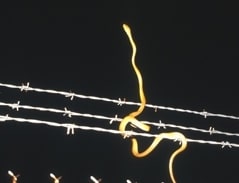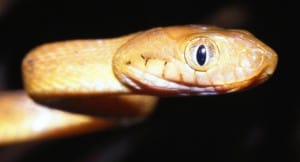Share this article
The economic case for invasive brown tree snake management
In recognition of National Invasive Species Awareness Week (Feb. 21-27), USDA Wildlife Services is providing a two-part series on the economics of invasive species management.
A recent article in The Economist (“Day of the triffids,” Dec. 5, 2015) advocates the belief that “invasive species are more benign than is generally thought — and much harder to eradicate.” The author supports his claim by asserting that eradication campaigns, such as the brown tree snake effort on Guam, are costly and often fail.
Unfortunately, the article misses the mark. While it is true that eradicating invasive species is difficult and campaigns sometimes fail, the primary goal of most invasive species management efforts is to reduce their damage.

Millions of dollars have been spent to reduce the number of invasive brown tree snakes on Guam and prevent their spread. Economists at the USDA National Wildlife Research Center highlight the full economic benefits of the program. ©USDA Wildlife Services
“Since the late 1980s, USDA Wildlife Services has collaborated with other agencies in Guam to reduce brown tree snake numbers, prevent their spread, reclaim natural areas for the reintroduction of native wildlife, protect endangered species, improve public health, and protect power stations and other sensitive locations from intrusion,” states Dr. Shane Siers, a supervisory research biologist with the WS National Wildlife Research Center (NWRC). “There has never been an attempt to eradicate the brown tree snake from Guam. Our goal is to keep damage down and prevent the snake’s spread to Hawaii, Saipan and other sensitive areas.”
To achieve these aims, NWRC research encompasses the development of repellents, attractants, toxicants, fumigants, reproductive inhibitors and improved trapping and baiting methods — including a new aerial bait delivery system.
Skeptics may assert such research and operational efforts are too expensive, but how do they compare to the costs of an unmanaged snake population?
The brown tree snake effort on Guam offers a good case study for how economic information can help drive support for invasive species management. In an earlier eWildlifer article (“Economics of Invasive Species Management,” Shwiff), NWRC economist Dr. Stephanie Shwiff discussed how the use of regional economic models helps scientists talk about invasive species damage in terms of jobs and the economy.
“On Guam, the direct damages from brown tree snakes are clear. Only two of the 12 native forest bird species on the island remain, $4 million is lost annually in productivity from snakes electrocuting themselves on power lines, and one out of 1,000 emergency room visits results from a snake bite,” Siers notes. Estimates of the snakes’ impacts to Guam’s tourism have not been measured.
To some, this still may not be enough to justify the $7 million annual cost of Guam’s brown tree snake research and management. Therefore, NWRC economists went a step further and estimated the potential future impacts if the snakes were to similarly colonize Hawaii.
Economic models predicted that the establishment of a population of brown tree snakes in Hawaii would result in an estimated $593 million to $2.14 billion in yearly damages to Hawaii’s economy and the loss of 1,400 to 13,000 jobs. This included costs of snakebite medical treatments, snake-caused power outages, and decreased tourism resulting from effects of the snake. Needless-to-say, even if brown tree snakes were to eventually become established in Hawaii, every year that interdiction efforts on Guam delay such an event is an economic victory.
The concerted, sustained and thoughtful multi-agency approach to confronting Guam’s brown tree snake problem is a model of success to all who see beyond defeat or eradication as the only conceivable outcomes of invasive species management.
Wildlife Services is a strategic partner with The Wildlife Society.
Header Image: ©USDA Wildlife Services









